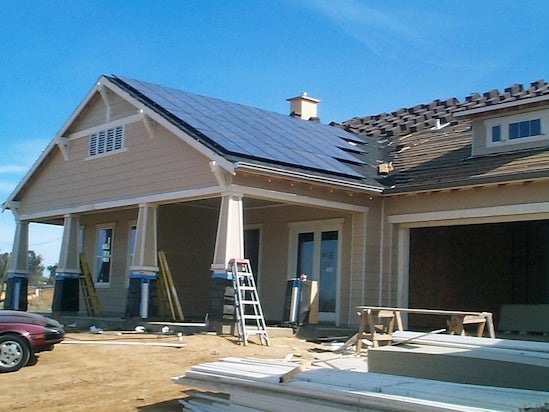That’s the conclusion of a report from the Lawrence Berkeley National
Laboratory released last week (Dec. 12), which found that a new
photovoltaic installation on a home leads to a $5,911 price boost per
kilowatt installed—at least in California, where the report, “Exploring California PV Home Premiums”
gathered data from. The report is an important sign that not only is
solar good for the current homeowner, it’s also becoming more attractive
to future homeowners.
In the past there has been some debate as to whether or not solar power,
particularly PV, added value to homes. This report and a former, 2011
report from the LBL, offer compelling proof that in the nation’s largest
homeowner market, that PV does add value.

Part of the issue behind properly assessing the amount that solar
adds in value to a home is that appraisers didn’t assign value to the PV
array. “Still, some appraisers and other home valuers assign no value
to a home’s PV system, and those who do often cannot find comparable
home sales to help determine the PV premium,” the report stated.
Those appraisers that have attempted to calculate the value of solar
on homes have tried looking at a number of ways to do so, including the
value generated by the PV array over time and the installed cost
equivalent of the system. The LBL report looks at the issues in a more
cohesive way. It used regression analysis to determine PV home sales
premiums, explores difference between size and age and compares actual
premium to predictions based on the other approaches of to evaluating
the premium that PV adds to a home.
“Our analysis offers clear support that a premium exists in the
marketplace; thus, PV systems have value, and their contribution to home
values must be assessed,” wrote lead report authors Ben Hoen and
Geoffrey Klise in an executive summary of the report. “We find that
premiums in California are strongly correlated with PV system size and
weakly correlated with PV system age.” So while a new system adds $5,911
per kilowatt, each year the system ages drops the premium by $2,411.
The report also finds that a newer system adds more value than an older
system particularly after it has reached 6 years in age. Still, there is
an increasingly significant number of new homes in the state with solar.
The premiums people were willing for were also higher than expected
showing that solar adds further value to homes. The study said there
could be a number of reasons. Among them, the “green cachet” added by a
solar array, but also potential avoided transaction costs,
utility-specific retail rates and tiered rates and some other effects
that could overvalue a PV array.
Still, the data is limited because it focusses only on the California
market. The researchers suggested that in the future, such studies
should look at additional markets and recent crash and subsequent
recovery in the home market. It also suggested looking at whether
outright system ownership affects the cost as opposed to third-party
ownership. “These further investigations will help improve our
collective understanding of PV premiums, and will help further tune the
income and cost based valuation tools that develop to predict the impact
of PV systems on homes prices.
The original article was published on Solar review's
No comments:
Post a Comment